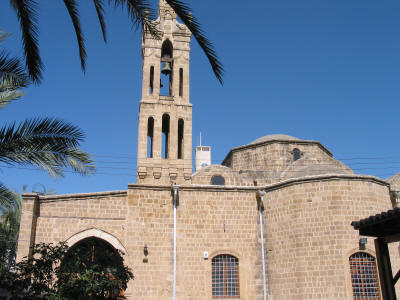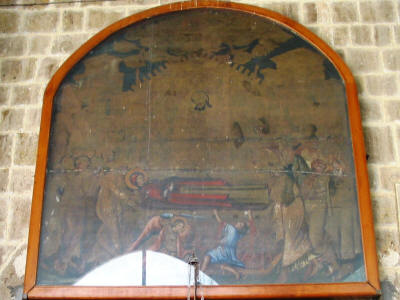The Church of Archangel Michael Trypiotis
Nicosia, South Cyprus
 |
| The Church of Archangel Michael Trypiots |
The foundation stone of the church of Archangel Michael Trypiotis was laid by Archbishop Germanos II of Cyprus (1690 - 1705) on the 3rd of May 1695. It is thought that this building, however, replaced a much older Gothic church. According to the engraved marble inscription set in the wall high above to the right of the main south door, the church was completed in a remarkably short time, on the 25th November of the same year. The church was built from the donations of the Christian parishioners and the priest Iacovos, showing that one hundred and thirty five years after the Turkish occupation of the island, the orthodox community had recovered sufficiently to be able to raise churches of this size.
It is thought that during the Lusignan and Venetian periods (1191AD to 1570AD) an orthodox monastery existed in the same location.
The name “Trypiotis”, (in Greek it means “he who has made a hole”) was the name of a monastery in South East Anatolia. According to tradition, at Honae the infidels tried to destroy the monastery by changing the course of two nearby rivers. The Archangel answered the abbot’s prayers for help and came to save the monastery. With the sign of the cross he stemmed the flow of the torrents. With his spear he incised a cross on a large stone in front of the church. The stone split forming a large hole, the water flowed under the church and so the monastery was saved.
The church of Trypiotis is dedicated to Archangel Michael and it celebrates, each year, on the 6th of September, the date attributed to the miracle at Honae.
The church is a Franco/Byzantine domed basilica with three aisles and is set on an almost perfect square plan. The three aisles are separated by two rows of arches, each resting on a row of four unequally spaced columns. It is built of well-dressed sandstone, the same honey coloured stone as used for the city walls and all public buildings in old Nicosia.
 |
| The Assumption of the Virgin Mary |
The spacious narthex (entrance hall) on the south side leads to the arched, main entrance. Above the entrance there is a semicircular panel depicting the Assumption of the Virgin. The Archangel is shown giving battle with the Devil under her litter.
The panel forming the lintel is a has relief of carved marble, which must have come from a much older building, the style is that prevalent in Romanised Europe. It stands on two frieze-like capitals of the same period and shows a human form with a lion on each side being subdued. Similar marble lintels with coats of arms are to be found on the north door and on one of the two doors on the west wall. These are of a more recent age and must have come from the ruins of medieval palaces and other buildings.
Like in all orthodox churches the altar is separated from the main body of the church by an iconostasis, a gilded, elaborately carved wooden partition, which “carries the icons”. The one in Trypiotis was carved in 1812 and was gilded in 1816. The most important icon is a small wooden panel on the south wall at the extreme right-end of the iconostasis; it shows the Madonna and Child between Joachim and Anna. It dates from the 15th century and shows strong Italian influences. Above it there is a more recent wall painting depicting the miracle at Honae.
The icon of Archangel Michael, also at the extreme right of the iconostasis, is signed by the well- known painter Paul and is dated 1634. It must have come from an older church as it dates from before the construction of Trypiotis. According to the Byzantine iconography the saint is shown armed, in full panoply and with two enormous wings.
Together with Archangel Gabriel, the other taxiarchis” (i.e. commander) of the celestial host, they are celebrated on 8th November each year.
On the left-hand side of the iconostasis the icon of Saint Sypridon is the work of the monk loannikios and is dated 1755. Two other icons, that of Saint George and of Saint Nicolas are attributed to the same painter. The remaining icons are of the nineteenth century.
 |
| The Entrance Lintel |
The internal walls are not plastered, and they show the same well finished simplicity of the outside walls. They form a pleasant contrast with the rich gilded iconostasis and the icons encased in silver. In the Byzantine tradition icons are often clad in silver, or sometimes gold, showing only the faces and hands of the original painting.
A precious ornament from the church is the gilded silver cover of a printed Gospel dating from 1768 decorated with reliefs depicting the life of Christ and of the Virgin. Three of the panels were used in a Christmas 2000 commemorative stamp series.
Because of the rich and powerful families that lived there, Trypiotis was one of the most important parishes in Nicosia. It was known by the Turkish name of “pash mahallas” i.e. the “principal quarter”. With the spreading of Nicosia in the areas outside the walled-city and with the 1974 invasion and division of the city the parish lost many of its former parishioners and hence its predominance.
However, many Nicosians, notwithstanding where they live, bear a strong affection for the church and choose to be married or have their children baptised there.
See the location in Google maps
Back to South Nicosia Index